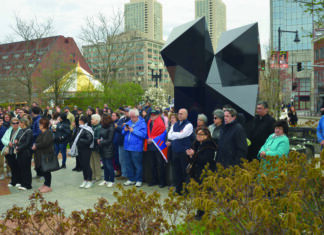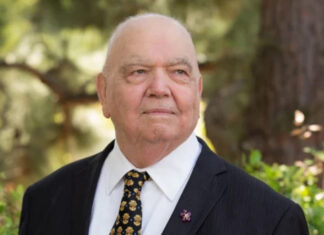By Aram Arkun
Mirror-Spectator Staff
BOSTON — The Bostonian Society on December 17 held a press conference at the Old State House to discuss recent revelations concerning the red book discovered in a time capsule prepared by Moses Gulesian, an Armenian-American who had immigrated to Boston in the late 19th century from Marash in the Ottoman Empire. The time capsule, actually a copper metal box, had been placed inside the head of the copper sculpture of a lion on top of the Old State House.
The red book and the time capsule were on display, and Brian LeMay, president and executive director of the Bostonian Society and Elizabeth Roscio, Archivist, Bostonian Society (caretaker of time capsule) spoke. Julie Hedgepeth, Communications Associate of the same society, facilitated the meeting. Architect Donald (Don) Tellalian, involved in restoration work of the Old State House, participated with his wife Barbara, and Marc Mamigonian, academic director at the National Association of Armenian Studies and Research, was present. Press representatives in attendance included Steve Kurkjian of the Boston Globe.
The existence of the time capsule had been forgotten for many decades, but a descendant of one of the men involved in the preparation of the contents of the capsule had found some notes indicating its existence and inquired about it to the Bostonian Society. Independently, the Tellalians became aware of its existence through old records.
When the appropriate time for renovations of the sculptures arrived in 2014, the Bostonian Society was ready to investigate further. Restorer Bob Shure of Skylight Studios used a tiny fiber optics camera to scan the inside of the head of the lion. This confirmed the existence of a shoebox-size object inside, and so the crown was removed and the capsule found, but a new mystery emerged. A red book, titled Papers Relating to the Foreign Relations of the United States, with the Annual Message of the President Transmitted to Congress December 7, 1896, and the Annual Report of the Secretary of State (Washington, 1897) was found placed at the top of the contents of the snug metal box. Puzzlingly, this volume was not listed in the contemporary accounts of the time capsule’s contents in a 1901 newspaper article.









